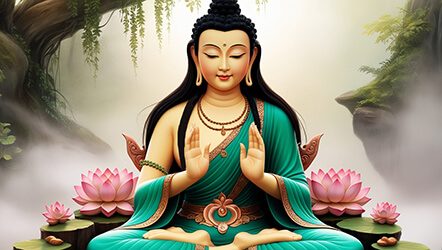
Green Tara Mantra and Stories
Green Tara is known as the Mother of All Buddhas. She is often depicted as a woman seated or standing on a lotus throne. Sometimes her garments are green. At other times, Tara herself has green skin. This associates her with fertility, nourishment, life and growth, including flowers, plants and trees.
Green Tara and the Female Buddhas
The female buddhas are generally less well known than their male counterparts. However, the masculine buddhas all have feminine consorts with their own characteristics and mantras. When taken together, the masculine and feminine forms are a balanced whole. Tara is the consort of the Dhyani Buddha known as Amoghasiddhi.
Share this page with a friend!
Watch nearly 400 videos on the Vocal Medicine Channel!
Green Tara: Buddha of Compassion
Tara is a Buddhist deity known as the goddess of liberation. In the Tibetan pantheon of deities, Tara is the consort of the Dhyani Buddha Amogasiddhi. Tara means “star.” The word-name Tara is variously interpreted as Shining Star, Liberator, Savior, or One Who Ferries Across. Tara is the most powerful female deity in the Buddhist pantheon.
Other Names of Tara
Tara exists as a goddess in many traditions and countries, including Hinduism, Polynesian mythology, Druidism, Finland (Tar, Woman of Wisdom), Roman mythology (Terra, Earth Mother), and South America (the goddess Tarahumara). Tara is one of the most important deities in Tibet, Nepal and Mongolia. Her Tibetan name is Drolma, meaning “she who sees.”
The Many Forms of Tara
There are 21 major forms of Tara, sometimes associated with colors. The Taras are a set of Bodhisattvas with varying qualities. Some of the more well-known are the following:
Green Tara: embodies compassion
Red Tara: a fierce goddess who magnetizes all good things
Black Tara: associated with power
Yellow Tara: associated with wealth and prosperity
Blue Tara: transmutation of anger
Names of Tara in Her Mantra
Tara is a Bodhisattva of compassion in action who manifests in female form. This mantra is called the Green Tara Mantra, a traditional Buddhist chant. The central part of Tara’s mantra is a loving play on her name. The variations of her name represent three progressive stages of salvation.
Three Stages of Salvation through Tara
Tāre represents salvation from mundane dangers and suffering. Tuttāre represents deliverance into the spiritual path conceived in terms of individual salvation. Lastly, Ture represents the culmination of the spiritual path in terms of deliverance into the altruistic path of universal salvation – the Bodhisattva path.
Symbolism of the Female Buddha Tara
The bodhisattva Tara is said to have been born out of the tears of Avolokitesvara as he looked down on the sorrows of the world. Tara’s right hand is in the mudra or gesture of giving. Her left hand is in the mudra of fearlessness. Depictions of Tara show her left leg tucked up in a meditation pose. Her right leg is stepping down into the world.
A Story about Tara
Tara is said to have been born out of the tears of compassion of Avalokitesvara. As he wept, a lake formed. A lotus sprang up. When the lotus opened, the goddess Tara emerged. In another story, Tara existed as a young princess named Yeshe Dawa, which means “wise moon.”
Becoming a Female Buddha
Yeshe Dawa had achieved great results in her spritual practice. A monk suggested that she pray to be born as a man in order to make further progress. At that, Yeshe replied that she vowed to be born as a woman in every lifetime. She also vowed to attain Buddhahood as a woman.
Mastery in Many World Systems
After this declaration, Yeshe entered a state of uninterrupted meditation for ten million years. This allowed her to manifest supreme enlightenment in many world systems. One of those world systems is ours. In our world system, she manifests as Tara.
Characteristics of the Female Buddha Tara
Chant to Akasa Dhatvisvara, the consort of Vairochana. Her name means “the sovereign lady of the sphere of infinite space.” She holds a blooming lotus in each hand and is associated with the symbols of the dharmacakra (the wheel of dharma) and the vajra-bell (lightning bell).
Color: Green
Element: Air
Symbol: Crossed Vajra
Direction: Center
Mudra: Ringing Vajra Bell
Seed Syllable: TAM
Overcomes: Envy & Fear
Function: All Functions
Wisdom: All Phenomena
Consort: Amoghasiddhi
Animal: Lioness
Name: Shining Star
GREEN TARA ARTICLE SUMMARY
Green Tara is a form of the Goddess Tara that exists as a goddess in many traditions and countries. There are many forms of Tara, a female Buddha. Green Tara is known for the quality of compassion. This article discusses her symbols, mantra and the stories of her origin.
Click for all content on our Site Map
Author Kathleen Karlsen
Kathleen Karlsen is a musician, artist, writer and speaker. She is the author of two books (Flower Symbols and Vocal Medicine) and over 200 articles. Kathleen, her husband Andrew, and their five children live in Bozeman, Montana. More about Kathleen Karlsen.
Watch nearly 400 videos on the Vocal Medicine Channel!







